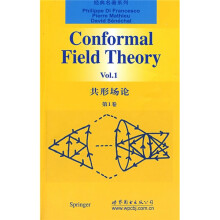Preface
PartA INTRODUCTION
1 Introduction
2 Quantum Field Theory
2.1 Quantum Fields
2.1.1 The Free Boson
2.1.2 The Free Fermion
2.2 Path Integrals
2.2.1 System with One Degree of Freedom
2.2.2 Path Integration for Quantum Fields
2.3 Correlation Functions
2.3.1 System with One Degree of Freedom
2.3.2 The Euclidiall Formalism
2.3.3 The Generating Funcfional
2.3.4 Example:The Free Boson
2.3.5 WickS Theorem
2.4 Symmetries andConservationLaws
2.4.1 Continuous Symmetry Transformations
2.4.2 Infinitesimal Transformations and Noethers Theorem
2.4.3 Transformation of the Correlation Functions
2.4.4 Ward Identities
2.5.1 The Energy-Momentum Tensor
2.5.1 The Belinfante 1lensor
2.5.2 Alternate Definition of the Energy-Momentum Tensor
2.A Gaussian Integrals
2.B Grassmann Variables
2.C Tetrads
Exercises
3 Statistical Mechanics
3.1 11le Boltzmann Distribution
3.1.1 Classical Statistical Models
3.1.2 Quantum Statistics
3.2 Critical Phenomena
3.2.1 Generalities
3.2.2 Scaling
3.2.3 Broken Symmetry
3.3 The Renormalization Group:Lattice Models
3.3.1 Generalities
3.3.2 The Ising Model on a Triangular Lattice
3.4 The Renormalization Group:Continuum Models
3.4.1 Introduction
3.4.2 Dimensional Analysis
3.4.3 Beyond Dimensional Analysis:The
3.5 The Transfer MaUix
Exercises
Part B FUNDAMENTALS
4 GIobal Conformal Invariance
4.1 The Conformal Group
4.2 Conformal Invariance in Classical Field Theory
4.2.1 Representations of the Conformal Group in d Dimensions
4.2.2 The Energy-Momentum Tensor
4.3 Conformal Invariance in Quantum Field Theory
4.3.1 Correlation Functions
4.3.2 Ward Identifies
4.3.3 Tracelessness of Tuv in Two Dimensions
Exercises
5 Conformai Invariance In Two Dimensions
5.1 The Conformal Group in Two Dimensions
5.1.1 Conformal Mappings
5.1.2 Global Conformal Transformations
5.1.3 Conformal Generators
5.1.4 Primary Fields
5.1.5 Correlation Funcfions
5.2 Ward Identities
5.2.1 HolomorphicFormoftheWardIdentities
5.2.2 The Conformal Ward Idcntity
5.2.3 Alternate Derivation of the Ward Identities
5.3 Free Fields and the Operator Product Expansion
5.3.1 The Free Boson
5.3.2 Tt Free Fermion
5.3.3 The Ghost System
5.4 the Central Charge
5.4.1 Transformation of the Energy-Momentum Tensor
5.4.2 Physical Meaning of C
5.A The Trace Anomaly
5.B The Heat Kemel
Exercises
6 The Operator Formalism
6.1 The Operator Formalism of Conformal Field Theory
6.1.1 Radial Quantization
6.1.2 Radial Ordering and Operator Product Expansion
6.2 The Virasoro Algebra
6.2.1 Conformal Generators
6.2.2 The Hilbert Space
6.3 The Free Boson
6.3.1 Canonical Quantization on the Cylinder
6.3.2 Vertex Operators
6.3.3 The Fock Space
6.3.4 Twitled Boundary Conditions
6.3.5 Compactified Boson
6.4 1 the Free Fermion
6.4.1 Canonical Quantization on a Cylinder
6.4.2 Mapping onto the Plane
6.4.3 Vacuum Energies
6.5 Nor mal Ordering
6.6 Conformal Families and Operator Algebra
6.6.1 Descendant Fields
6.6.2 Conformal Families
6.6.3 The Operator Algebra
6.6.4 Conformal Blocks
6.6.5 Crossing Symmetry and the Conformal Bootstrap
6.A Vertex and Coherent States
6.B The Generalized Wick Theorem
6.C A Rearrangement Lemma
6.D Summary of Important Formulas
Exercises
7 Minimal Modds I
7.1 verma Modules
7.1.1 Highest-Weight Representations
7.1.2 Virasoro Characters
7.1.3 Singular vectors and Reducible Verma Modules
7.2 the Kac Determinant
7.2.1 Unitarity and the Kac Determinant
7.2.2 Unitarity of C≥l Representations
7.2.3 Unitary C

 缺书网
缺书网 扫码进群
扫码进群





